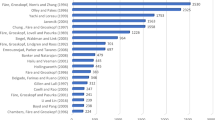Abstract
Two different Malmquist productivity indexes have been proposed. One I call partially oriented because it is either output- or input-oriented, and the other is simultaneously output- and input-oriented. The partially oriented Malmquist index owes some of its popularity to the fact that it has been decomposed to isolate various sources of productivity change. Conversely, the simultaneously oriented Malmquist index has not achieved popularity in part because it has not been decomposed. In this paper I evaluate alternative decompositions of the partially oriented Malmquist index, and I obtain a new decomposition of the simultaneously oriented Malmquist index. This new decomposition leads me to conclude that the latter index is deserving of greater attention than it has received to date.
Similar content being viewed by others
References
Balk, B. (1993).“Malmquist Productivity Indexes and Fisher Ideal Indexes: Comment”Economic Journal 103(415) (May), 680–682.
Balk, B. M. (1998). Industrial Price, Quantity, and Productivity Indices: The Micro-Economic Theory and an Application. Boston: Kluwer Academic Publishers.
Balk, B. M. (2001).“Scale Efficiency and Productivity Change”Journal of Productivity Analysis 15(3) (May), 159–183.
Bauer, P. W. (1990).“Decomposing TFP Growth in the Presence of Cost Inefficiency, Nonconstant Returns to Scale, and Technological Progress”Journal of Productivity Analysis 1(4) (June), 287–299.
Bjurek, H. (1994). Essays on Efficiency and Productivity Change with Applications to Public Service Production. Ekonomiska Studier 52, School of Economics and Commercial Law, University of Gothenburg, Sweden.
Bjurek, H. (1996).“The Malmquist Total Factor Productivity Index”Scandinavian Journal of Economics 98(2), 303–313.
Bjurek, H., F. R. Førsund and L. Hjalmarsson. (1998). Malmquist Productivity Indexes: An Empirical Comparison. In R. Fä re, S. Grosskopf and R. R. Russell (eds.), Index Numbers: Essays in Honour of Sten Malmquist. Boston: Kluwer Academic Publishers.
Caves, D. W., L. R. Christensen and W. E. Diewert. (1982).“The Economic Theory of Index Numbers and the Measurement of Input, Output, and Productivity”Econometrica 50(6) (November), 1393–1414.
Denny, M., M. Fuss and L. Waverman. (1981). The Measurement and Interpretation of Total Factor Productivity in Regulated Industries, with an Application to Canadian Telecommunications. In T. G. Cowing and R. E. Stevenson(eds.), Productivity Measurement in Regulated Industries. New York: Academic Press.
Diewert, W. E. (1992).“Fisher Ideal Output, Input and Productivity Indexes Revisited”Journal of Productivity Analysis 3(3) (September), 211–248.
Fisher, F. M. and K. Shell. (1972). The Economic Theory of Price Indices: Two Essays on the Effects of Taste, Quality and Technological Change. New York: Academic Press.
Färe, R., E. Grifell-Tatjé, S. Grosskopf and C. A. K. Lovell. (1997a).“Biased Technical Change and the Malmquist Productivity Index”Scandinavian Journal of Economics 99(1), 119–127.
Färe, R. and S. Grosskopf. (1992).“Malmquist Productivity Indexes and Fisher Ideal Indexes”Economic Journal 102(410) (January), 158–160.
Färe, R. and S. Grosskopf. (1996). Intertemporal Production Frontiers: With Dynamic DEA. Boston: Kluwer Academic Publishers.
Färe, R., S. Grosskopf, B. Lindgren and P. Roos. (1994a). Productivity Developments in Swedish Hospitals: A Malmquist Output Index Approach. In A. Charnes, W. W. Cooper, A. Y. Lewin and L. M. Seiford (eds.), Data Envelopment Analysis: Theory, Methodology and Applications. Boston: Kluwer Academic Publishers. (Originally presented at a Conference on New Uses of DEA in Management and Public Policy, University of Texas, Austin, TX, September 27–29, 1989.)
Färe, R., S. Grosskopf and M. Norris. (1997b).“Productivity Growth, Technical Progress, and Efficiency Change in Industrialized Countries: Reply”American Economic Review 87(5) (December), 1040–1043.
Färe, R., S. Grosskopf, M. Norris and Z. Zhang. (1994b).“Productivity Growth, Technical Progress, and Efficiency Change in Industrialized Countries”American Economic Review 84(1) (March), 66–83.
Färe, R., S. Grosskopf and P. Roos. (1996).“On Two Definitions of Productivity”Economics Letters 53, 269–274.
Färe, R., S. Grosskopf and P. Roos. (1998). Malmquist Productivity Indexes: A Survey of Theory and Practice. In R. Färe, S. Grosskopf and R. R. Russell (eds.), Index Numbers: Essays in Honour of Sten Malmquist. Boston: Kluwer Academic Publishers.
Førsund, F. R. (1996).“The Malmquist Productivity Index, TFP and Scale”Memorandum No. 233, Department of Economics, University of Göteborg, Sweden.
Gilbert, R. A. and P. W. Wilson. (1998).“Effects of Deregulation on the Productivity of Korean Banks”Journal of Economics and Business 50(2) (March/April), 133–155.
Grifell-Tatjé, E. and C. A. K. Lovell. (1999a).“Profits and Productivity”Management Science 45(9) (September), 1177–1193.
Grifell-Tatjé, E. and C. A. K. Lovell. (1999b).“A Generalized Malmquist Productivity Index”Top 7(1), 81–101.
Grifell-Tatjé, E. and C. A. K. Lovell. (2000).“Cost and Productivity”Managerial and Decision Economics 21(1) (January/February), 19–30.
Hicks, J. R. (1961). Measurement of Capital in Relation to the Measurement of Other Economic Aggregates. In F. A. Lutz and D. C. Hague (eds.), The Theory of Capital. London: Macmillan.
Malmquist, S. (1953).“Index Numbers and Indifference Surfaces”Trabajos de Estadistica 4, 209–242.
Moorsteen, R. H. (1961).“On Measuring Productive Potential and Relative Efficiency”Quarterly Journal of Economics 75(3) (August), 451–467.
Nishimizu, M. and J. M. Page. (1982).“Total Factor Productivity Growth, Technical Progress and Technical Efficiency Change: Dimensions of Productivity Change in Yugoslavia, 1965–1978”Economic Journal 92, 920–936.
Orea, L. (2002).“Parametric Decomposition of a Generalized Malmquist Productivity Index”Journal of Productivity Analysis 18(1) (July), 5–22.
Ray, S. C. (2002).“On an Extended Decomposition of the Malmquist Productivity Index”Working Paper, Department of Economics, University of Connecticut, Storrs, CT 06269–1063, USA.
Ray, S. C. and E. Desli. (1997).“Productivity Growth, Technical Progress, and Efficiency Change in Industrialized Countries: Comment”American Economic Review 87(5) (December), 1033–1039.
Shephard, R. W. (1953). Cost and Production Functions. Princeton: Princeton University Press.
Shephard, R. W. (1970). Theory of Cost and Production Functions. Princeton: Princeton University Press.
Simar, L. and P. W. Wilson. (1998).“Productivity Growth in Industrialized Countries”Working Paper, Department of Economics, University of Texas, Austin, TX 78712, USA.
Wheelock, D. C. and P. W. Wilson. (1999).“Technical Progress, Inefficiency and Productivity Change in U.S. Banking, 1984–1993”Journal of Money, Credit and Banking 31(2) (May), 212–234.
Zofio, J. and C. A. K. Lovell. (1998).“Yet Another Malmquist Productivity Index Decomposition”Working Paper, Department of Economics, University of Georgia, Athens, GA 30602, USA.
Author information
Authors and Affiliations
Rights and permissions
About this article
Cite this article
Lovell, C.A.K. The Decomposition of Malmquist Productivity Indexes. Journal of Productivity Analysis 20, 437–458 (2003). https://doi.org/10.1023/A:1027312102834
Issue Date:
DOI: https://doi.org/10.1023/A:1027312102834




